In this episode of the guitar Timelines we examine what lies beyond Gibson’s best-known solidbody guitars.
Of course, it’s impossible to imagine Gibson without Les Pauls, SGs, Firebirds, Flying Vs, and the rest. Today, however, it’s the turn of some of the lesser-known model names from Gibson’s long and varied solidbody history.
This solid selection does include a few familiar shapes with different names, but mostly it’s an intriguing mix of should-have-beens and never-quite-made-its, together with a strong showing of esoteric outliers.
In other words, there’s plenty here to attract your attention, and even—who knows?—a few surprises awaiting fresh discovery.
Please note that for space reasons we have had to omit signature models, Custom Shop productions, and limited editions.
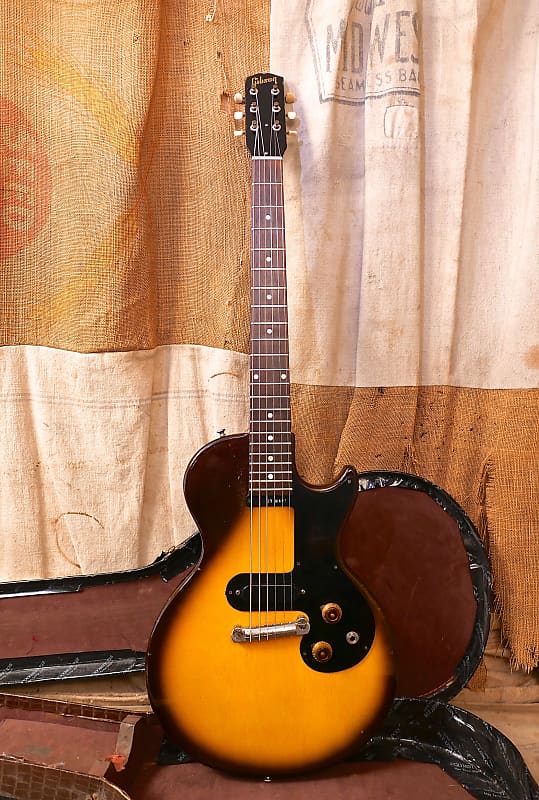
Gibson already had its budget Les Paul Junior but needed an even cheaper model. With no lowly Les Paul names left, the company came up with a wholly new model name: Melody Maker. Upon launch in 1959 it had a thinner Les Paul Junior-style mahogany body and neck, narrow head shape, unbound rosewood board with dots, Melody Maker (PU-380) single-coil at bridge, and a wrapover bridge/tailpiece. The body style then paralleled Les Paul changes, shifting to double-cut in ’61 and SG in ’66. A two-pickup version, the Double or D, also went through those changes of body style.
ALSO: ¾ (1959-70) Shorter scale, 12th-fret neck-body join. Melody Maker-III (1967–71) SG body, three pickups. Melody Maker-12 (1967–71) SG body, 12-string, two pickups. Melody Maker Double (1977–83) Double-cut, two pickups, Tune-o-matic. Melody Maker (1986–93) Single-cut, Tune-o-matic, one humbucker. All American II (1995–97) Double-cut, two single-coils, 24 frets, Strat-like vibrato. Les Paul Melody Maker (2003–06, 2014) Single-cut, P-90, Tune-o-matic, no pickguard; 2014 version maple neck, two P-90s, wrapover. Melody Maker / Melody Maker MM Raw (2008–12) Single-cut, one MM pickup, wrapover. Melody Maker Special (2011–13) Single-cut, two P-90s, wrapover. Melody Maker SG / Melody Maker Les Paul (2011–12) SG or Les Paul body, 491T humbucker, maple body, torrefied maple board, wrapover.
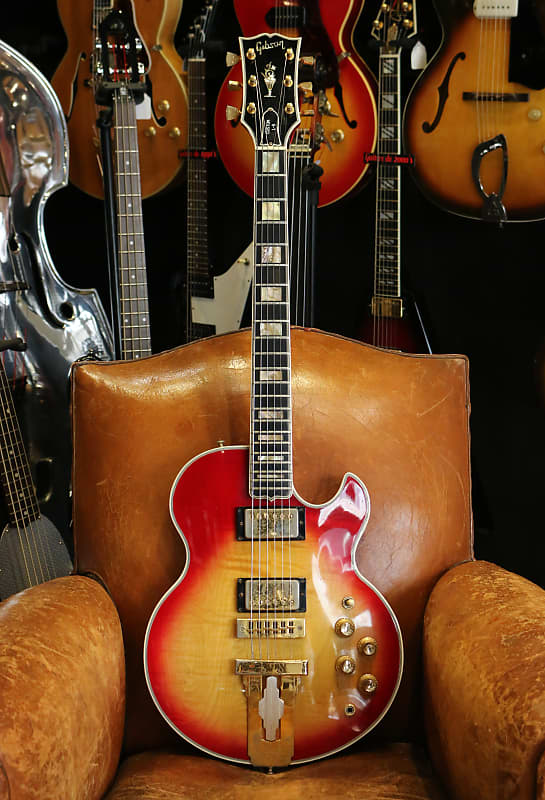
Borrowing some style and ornamentation from Gibson’s hollowbody acoustic L-5 and electric L-5CES, this high-end solidbody has a thin single-cut maple body, maple neck (later maple/mahogany), bound ebony board with abalone block markers, bound headstock with fancy inlay, gold-plated metalwork, two low-impedance pickups (Super Humbucking pickups from ’74), Tune-o-matic plus L-5-style tailpiece, no pickguard.
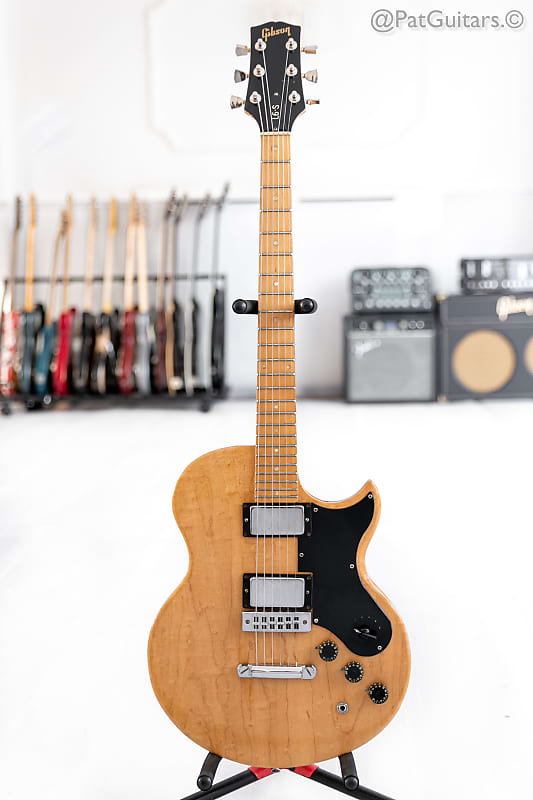
The L-6S is a single-cut solid designed by Bill Lawrence with maple body and neck, Tune-o-matic, and 24 frets.
- L-6S Custom (1973–80, known simply as L-6S until 1975) has an ebony or maple board depending on finish, two Lawrence-designed Super Humbucking pickups, three knobs for volume, midrange, and treble roll-off, and a six-way pickup rotary offering various series, parallel, and phase options.
- L-6S Deluxe (1975–80) was less expensive and has a rosewood board, two humbuckers with five-sided covers, two knobs (volume, treble roll-off) and a regular three-way toggle, through-body string anchoring.
- Midnight Special (1974–80) is similar to the Deluxe but with bolt-on neck and no body-top beveling.

Les Paul-shape single-cut with maple, mahogany, or alder body, bolt-on maple neck, maple board (some rosewood) with dots, pointed later-Flying-V-style headstock, three Bill Lawrence designed single-coils, volume and tone knobs, four-way rotary (neck+middle as humbucker/middle+bridge/all three/neck+middle out-of-phase), two-way toggle (four-way/bridge-pickup only), Tune-o-matic.
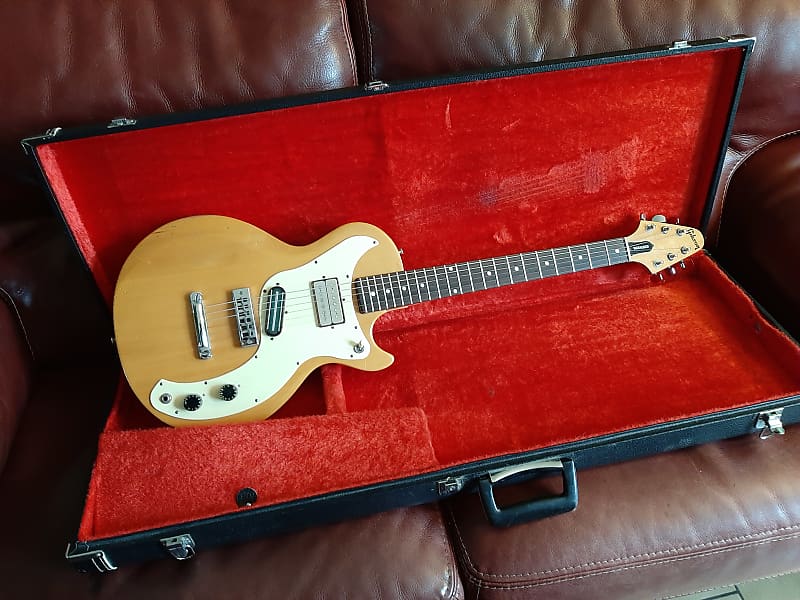
Similar to S-1 in shape, style, materials, and construction, but with a Lawrence-designed humbucker at neck and angled blade humbucker at bridge (some with clear covers). Volume and tone knob; pickup selector changed in type and location during the model’s life—sometimes a conventional three-way, sometimes a rotary blend. Lawrence’s L-6S, S-1, and Marauder brought new approaches to Gibson solid electrics during the Norlin period along with a strong hint of Fender competition.
ALSO: Marauder Custom (1976–77) Similar, but with bound rosewood board, block markers.
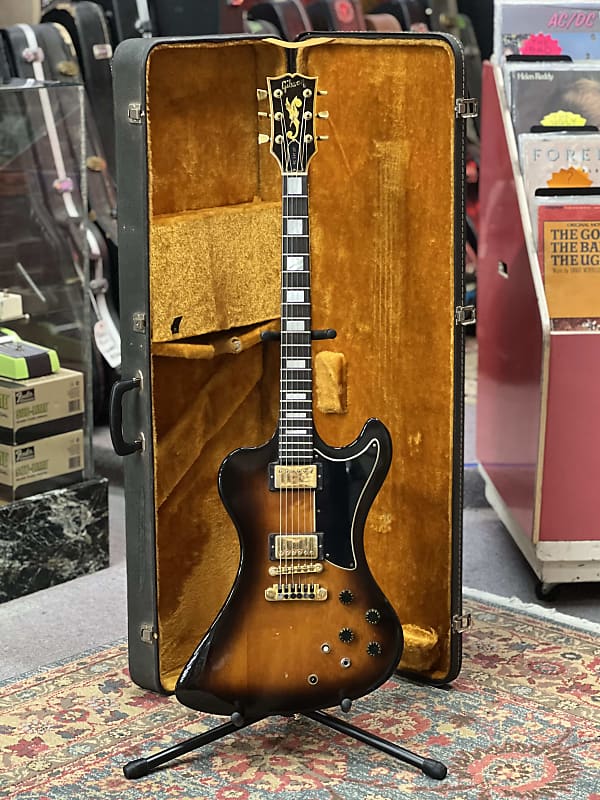
Gibson’s first active electronics came in the Firebird-like shape of the RD models, mixing active preamps with compression and expansion circuits devised by Moog—which like Gibson was owned by Norlin. All the RDs have a solid maple body and neck, and (all but one) a Fender-like 25.5-inch scale. There’s a regular model, the RD Standard (1977–79), without the electronics.
The fancy stuff sits in the RD Custom and RD Artist (1977–81), which share the same control layout: Four knobs (two regular volumes, one per pickup; active treble and bass (center-detented plus or minus 5), and two switches (a three-way toggle, plus for Custom: two-way active/bright–lead; or for Artist: three-way for compression-expansion mode/active mode/bright–lead mode). The Custom has a maple board, while the top-of-the-line Artist has an ebony board, TP-6 fine-tuning tailpiece, and fancy headstock inlay.
The Custom was sometimes known as RD Custom 77 (1979), the Artist as RD Artist 77 (1979–80), RD Artist 79 (1979–80, with regular Gibson scale and some control changes), and optionally as RD Artist CMT (1981), similar to Artist 79 but with curly maple top and bound board.
ALSO: RD Artist 40th Anniversary (2018) Mahogany body and neck, active GEM humbuckers, active preamp, volume per pickup, master tone, three-way toggle, granadillo board with crowns.
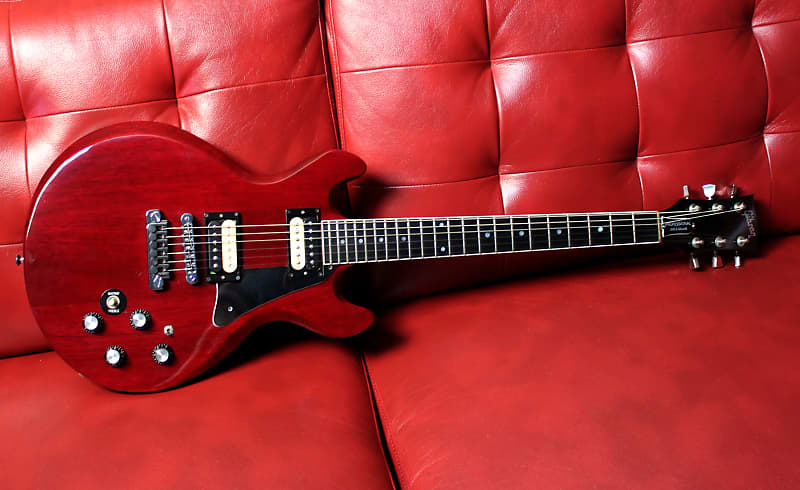
Designed by Whitey Morrison with a stripped-down solid take on the double-cut 335 shape, the shortlived 335-S models come in three flavors.
- 335-S Standard(1980–81) Maple or mahogany body and neck, rosewood board, two Super Humbucking pickups, Tune-o-matic, and branded-type headstock logo. Standards often have "Firebrand" on the truss-rod cover.
- 335-S Custom (1980–81) Mahogany body and neck, rosewood board, two Dirty Fingers humbuckers, coil-tap switch, TP-6 fine-tuning tailpiece, and branded logo. Customs often have "Firebrand" on the truss-rod cover.
- 335-S Deluxe (1980–82) Similar to Custom but bound ebony board, regular logo, strap locks, and a brass nut. Deluxes often have "Professional" on the truss-rod cover.
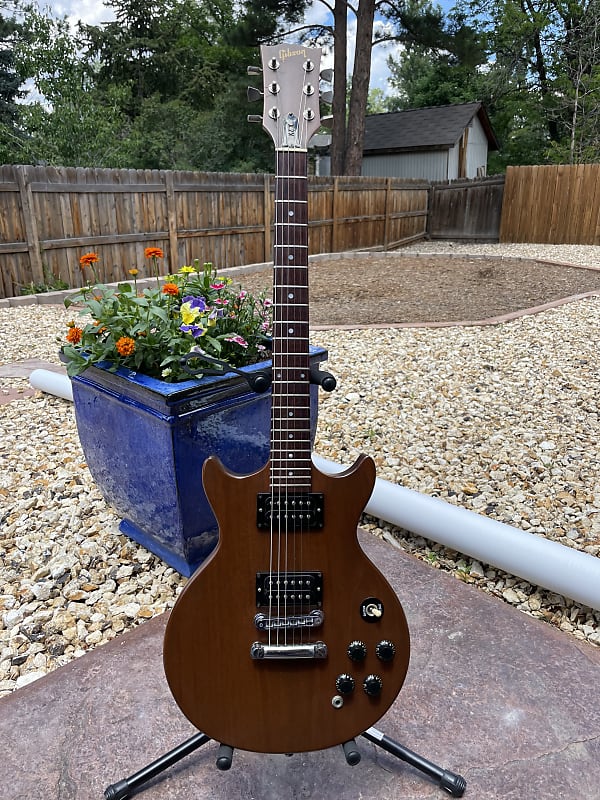
A short-lived model in the double-cut Les Paul Special/Melody Maker vein—and KZ refers to its birth place at Gibson’s Kalamazoo factory, which would close in ’84. It has a mahogany beveled-edge body and mahogany neck, rosewood board, two Dirty Fingers humbuckers, and no pickguard.
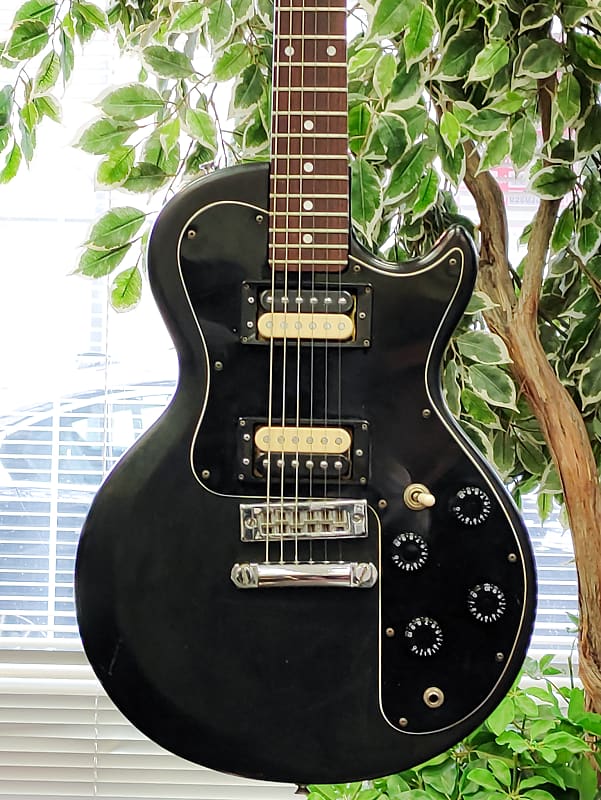
It’s a plastic Les Paul! To be more precise, the four Sonex models have Gibson’s "Multi-Phonic" beveled-edge body with maple core and molded resin outer.
- Sonex 180 Deluxe (1980–84) with two humbuckers, rosewood board.
- Sonex 180 Standard (1980) with two Super Humbucking or Dirty Fingers pickups, coil-tap switch, rosewood board.
- Sonex 180 Custom (1980–81) with two Dirty Fingers humbuckers, coil-tap switch, ebony board.
- Sonex Artist (1981–83) with active electronics and controls, TP-6 fine-tuning tailpiece, strap locks, no pickguard.
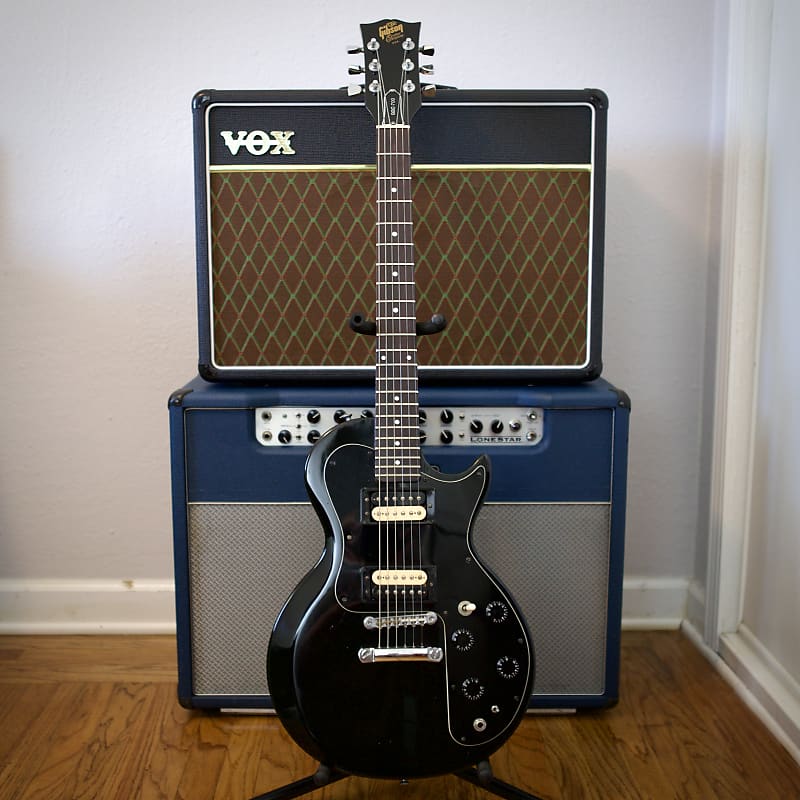
Coming on like a wood-body Sonex Standard, this model has a mahogany body, maple neck, rosewood board, two Dirty Fingers humbuckers, and coil-tap switch.

Boasting a distinctly Fender vibe, but definitely via Gibson, the two Victory models share a double-cut Strat-hinting maple body, maple neck, and Firebird-like headstock.
- Victory MV II (1981–84) has two Tim Shaw-designed humbuckers —Velvet Brick at neck, Magna II at bridge—bound rosewood board, volume and tone knobs plus Fender-style three-way toggle and coil-tap switch, Tune-o-matic and stopbar.
- Victory MV X (1981–84) has a bound ebony board, two Magna Plus humbuckers and a Super Stack stacked humbucker at center, and controls as II but with five-way selector.
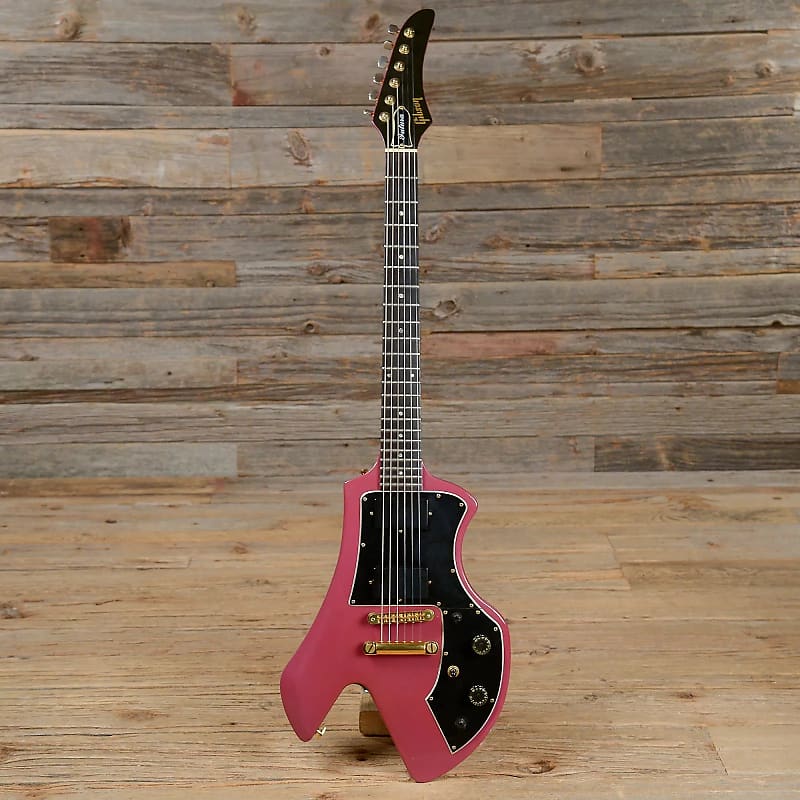
Gibson wanted a headless guitar to compete within an early-’80s market trend. Chuck Burge’s design had a notch in the body where the tuners absent from the nonexistent head should go, but marketing said no, it must have a head. The result was the bolt-on Corvus (in three variants: I, single humbucker; II, two humbuckers; III, three single-coils) and the through-neck Futura (gold-plated metalwork, TP-6 fine-tuning tailpiece, and vibrato option). No rude remarks, please.

Transferred from the Epiphone line, the Spirits were further contenders in Gibson’s double-cut Les Paul style, with "hardwood" body (Gibson code for "whatever’s available"), maple neck, and combined bridge/tailpiece. The Spirit I has a single Tim Shaw-designed humbucker at bridge, the Spirit II two humbuckers and no pickguard. Both were offered with an optional curly maple top.
ALSO: Spirit I XPL / Spirit II XPL (1985–86) Mahogany body and neck, one or two humbuckers, bound board, Explorer pointy headstock, Kahler vibrato, locking nut.
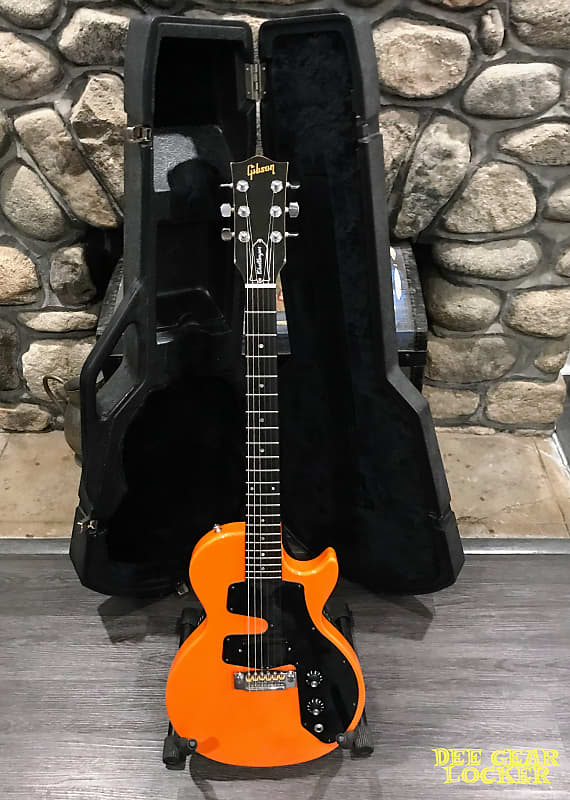
The Challengers were budget Les Paul-shape models with mahogany body, bolt-on maple neck, rosewood board, and combined bridge/tailpiece. They come in three versions: Challenger I with single humbucker at bridge; Challenger II with two humbuckers; and Challenger III with three single-coils.
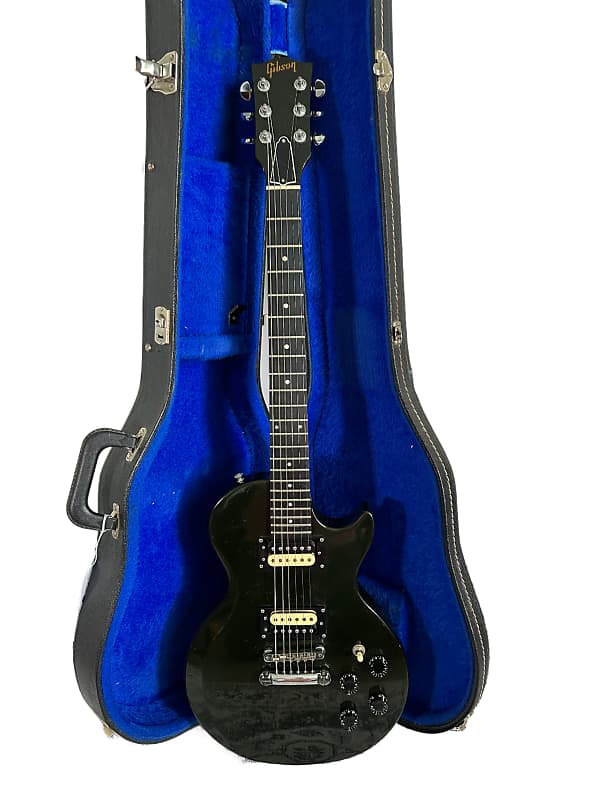
In the same budget mold as the Challenger models, with mahogany beveled-edge body, bolt-on maple or mahogany neck, and ebony board, the Invader leaned a little more to Les Paul features, with two humbuckers, regular controls, and Tune-o-matic plus stopbar.
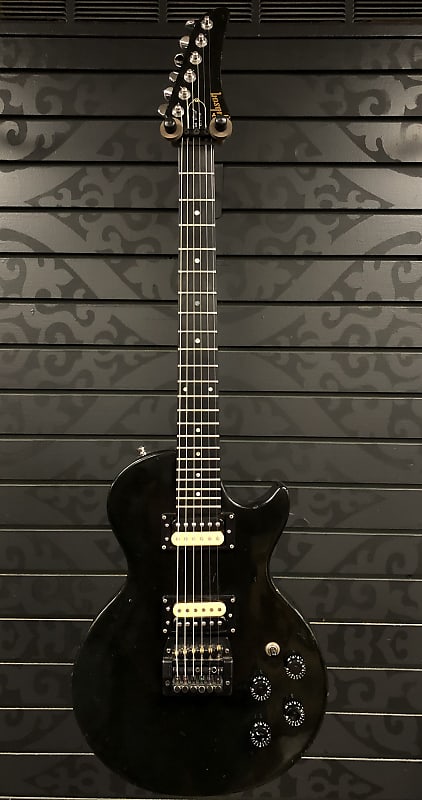
This short-lived Gibson has a mashup of contemporary features: Les Paul-shape beveled-edge body, bolt-on neck with ebony board, Corvus/Futura headstock, two humbuckers and regular controls, Kahler vibrato, locking nut.
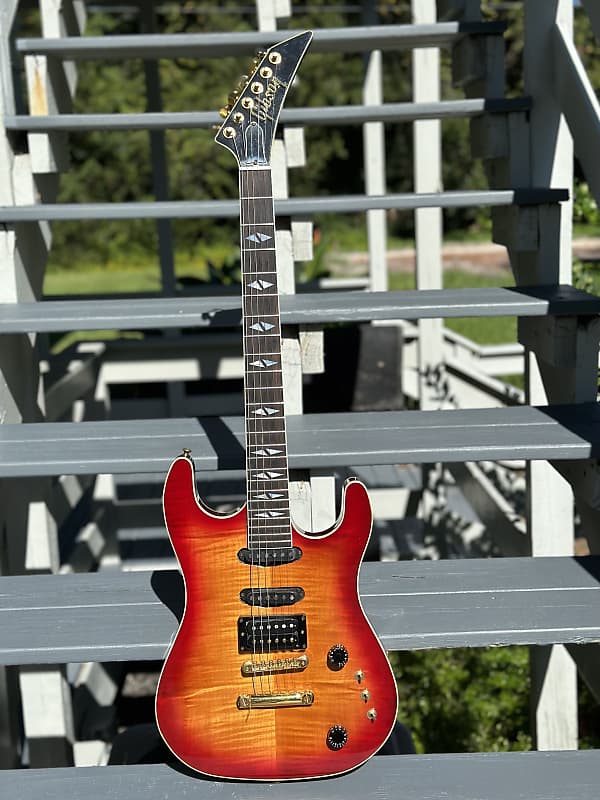
Gibson’s first attempt at a superstrat was a high-end model designed with input from Wayne Charvel. The bound body has a figured maple top, mahogany or maple back, and internal Chromyte (balsa) core, the maple neck has a bound 24-fret ebony board with split-diamond markers and 25.5-inch scale, and there’s a bound pointed headstock. There are two stacked humbuckers plus a regular humbucker at bridge, single volume (most with coil-tap push/pull) and tone knobs, and three pickup on/off switches, option of locking vibrato system (most Kahler) or Tune-o-matic plus stopbar, and gold or black-plated metalwork.
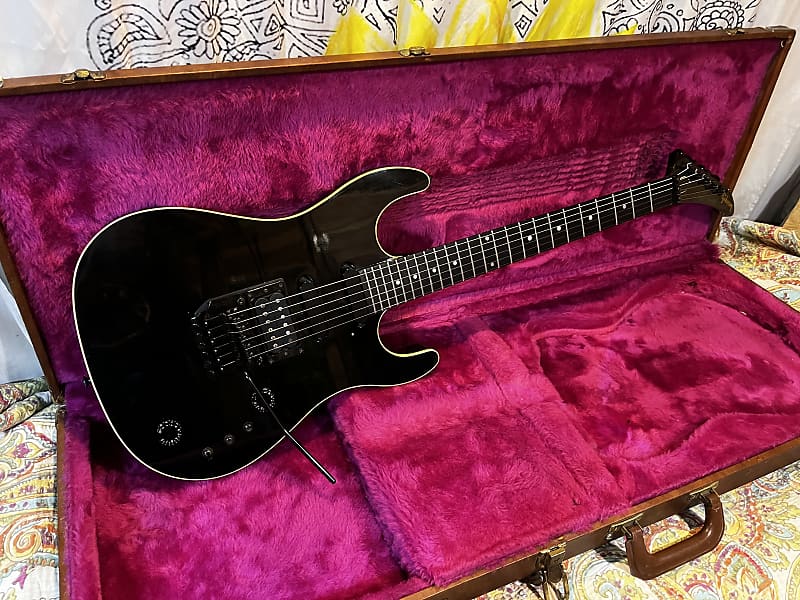
A further Gibson superstrat with Wayne Charvel input, half the list-price of the US-1, the basswood body with bound top and contoured back, the 24-fret 25.5-inch-scale maple neck with ebony board and dot markers, and a pointed headstock. Two single-coils plus humbucker at bridge, single volume and tone knobs, three pickup on/off switches, Floyd Rose vibrato, black-plated metalwork. Also known from 1989 as Mach II.
ALSO: Two further versions: one with two humbuckers, two knobs, selector, coil-split; the other with unbound body and fourth switch for bridge-pickup-on whatever other pickups status.
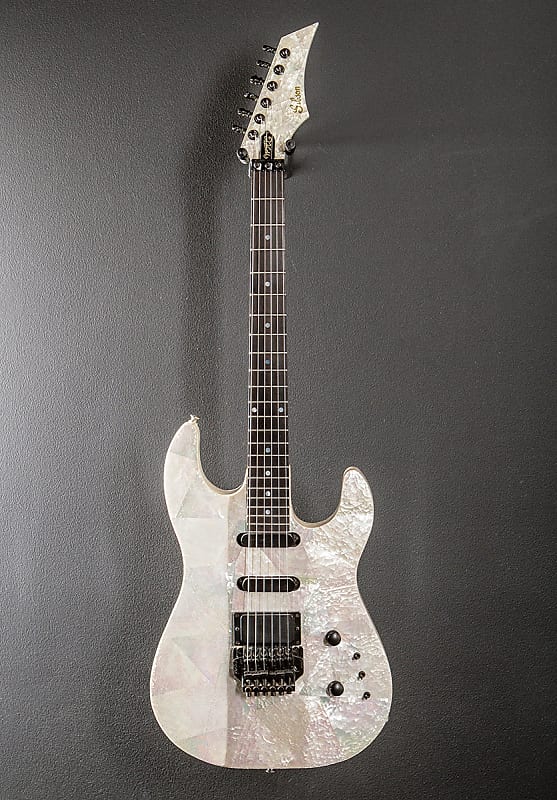
The third superstrat from the late ’80s with Wayne Charvel input was the suitably named WRC, boasting an alder body, 22-fret 25.5-inch-scale bolt-on maple neck with ebony board and dot markers, and a pointy headstock with Gibson script logo (some early examples with Charvel logo). Pickups are two stacked humbuckers plus a regular humbucker at bridge; single volume (with coil-tap push/pull) and tone knobs, three pickup on/off switches; Floyd Rose or Kahler vibrato; black-plated metalwork.
ALSO: Version with fourth switch for bridge-pickup-on, irrespective of other pickup settings.
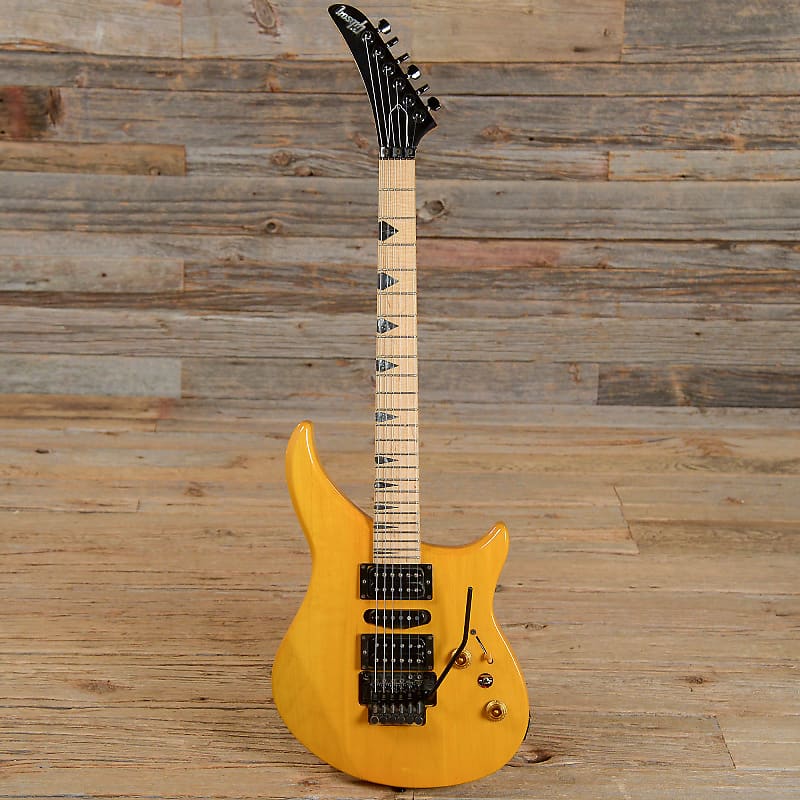
Gibson visited shredsville for the J.T. Riboloff-designed M models, the deep cutaways of their long-horned bodies offering speedy access to the 24th fret, and with a 25.5-inch scale topped by a reverse-pointed headstock.
- M-III Standard (1991–96) and M-III Deluxe (1991–93) have HSH pickups (496R+500T humbuckers, NSX single-coil), master volume and tone knobs, two-way coil-split toggle for single-coil mode (1) or humbucker mode (2), five-way selector (providing conventional selections for single-coil mode or for humbucker mode), Floyd Rose vibrato system, black-plated metalwork, maple neck and board with arrowhead markers, some Standards without pickguard; the Standard body is poplar, the Deluxe visibly sandwiched maple, walnut, poplar.
- M-III H versions (1991–92) of Standard and Deluxe have two humbuckers; volume, tone (with coil-tap), and three-way toggle.
- M-IV S Standard and M-IV S Deluxe (1993–96) are similar to the III versions but with a Steinberger vibrato and ebony board with dots (Standard) or arrowheads (Deluxe), and the Deluxe has a black limba body.
- M-III Stealth (1993) is similar to the M-IV S Deluxe but with Floyd Rose vibrato.
- M-III All American (1996–97) has a poplar body; maple neck with ebony board and dots; three humbuckers (500T bridge, two 496Rs); volume, tone (with coil-tap), and five-way; Steinberger vibrato; Steinberger tuners on triangular pointy head.
- ALSO: M-III Reissue (2013–18) Mahogany body, maple neck and board with arrowheads, Dirty Fingers HSH pickups, volume, tone (with coil-tap), and five-way, Floyd Rose vibrato.
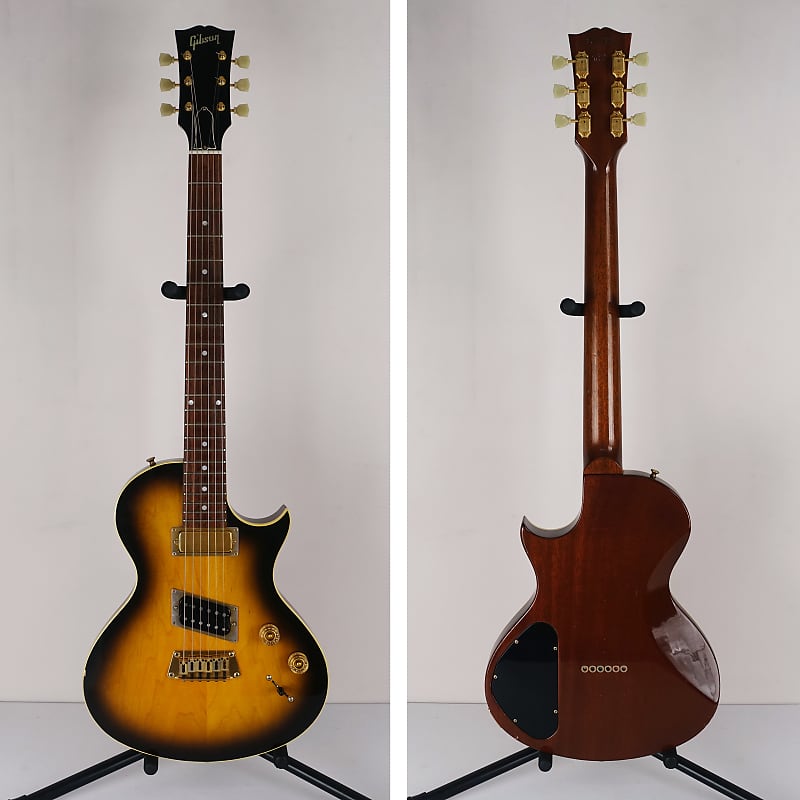
Coming on like wide, flat-topped, deep-cut Les Pauls, these models were designed by J.T. Riboloff. From 1995 they were known officially as the Hawk series.
- All Nighthawk models (1993–99) have a mahogany back with bound maple top, mahogany neck, 22 frets on a 25.5-inch scale, a combined bridge/tailpiece with through-body stringing, and gold-plated metalwork. Nighthawk Special has a rosewood board with dots; Nighthawk Standard has a figured top, bound rosewood board with twin angled blocks, a headstock inlay, and Floyd Rose options; Nighthawk Custom has a figured top, bound ebony board with fancy markers, a headstock inlay, and Floyd Rose options.
- Nighthawk models come with two or three pickups—M Series mini-humbucker at neck and M Series slanted humbucker at bridge; optional NSX single-coil at center. Two-pickup: Five-way selector offers bridge single/bridge hum/bridge+neck singles/neck single/neck hum. Three-pickup: Tone knob has a coil-split, in up position: bridge single/neck single+center/center/center+neck single/neck single; in down position: bridge hum/bridge hum+neck hum/neck hum/center+bridge hum/ neck single+bridge single.
- ALSO: The Hawk (1996–97) Mahogany body, rosewood board with dots; two 490R humbuckers; volume, tone, three-way; wrapover bridge/tailpiece. Landmark (1996–98) Similar to Nighthawk Special, but with two M Series mini-humbuckers; coil-split on tone knob, three-way. Nighthawk Studio (2011–12) Mahogany body, baked maple board, two Burstbucker pickups, coil-split on tone knob, three-way.
About the author: Tony Bacon writes about musical instruments, musicians, and music. His books include Electric Guitars: Design & Invention and Legendary Guitars. Tony lives in Bristol, England. More info at tonybacon.co.uk.
